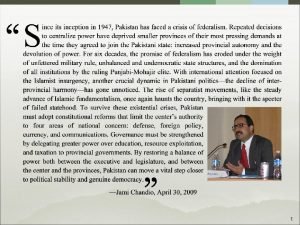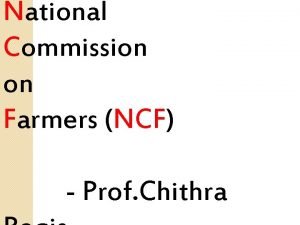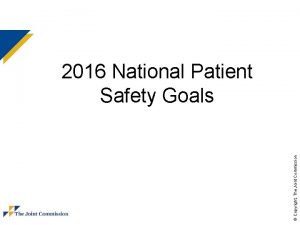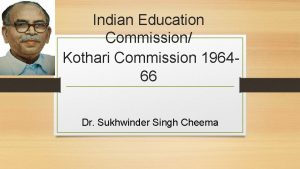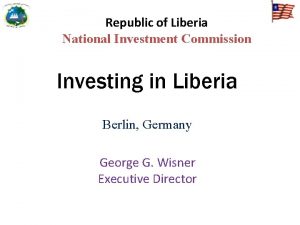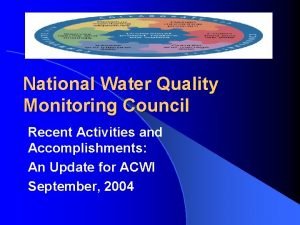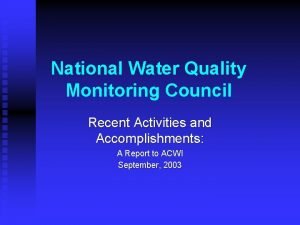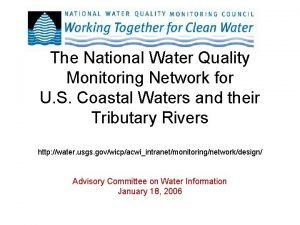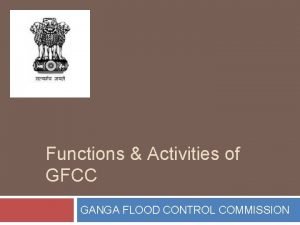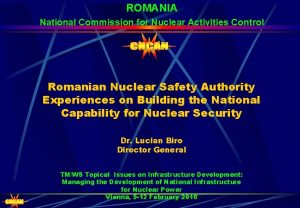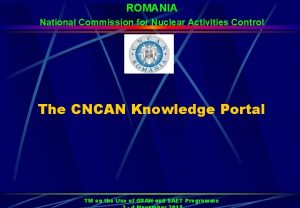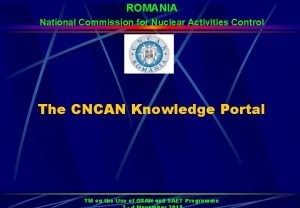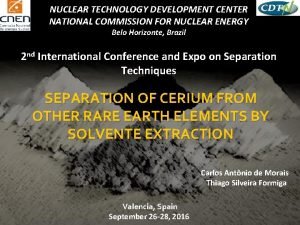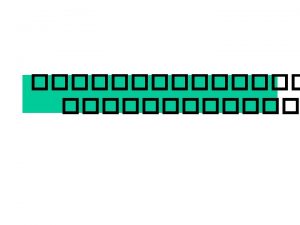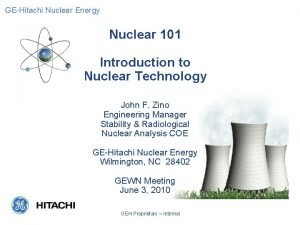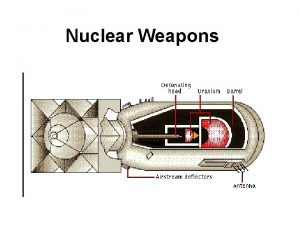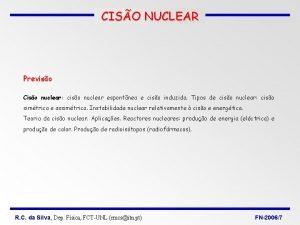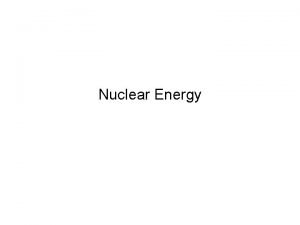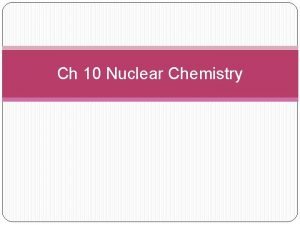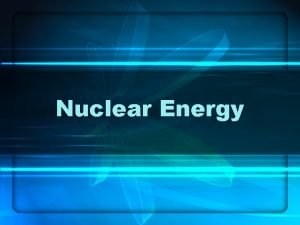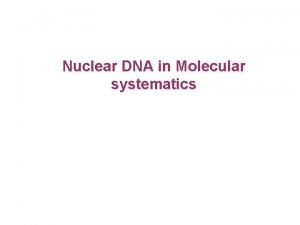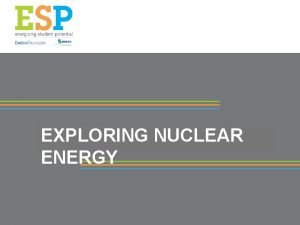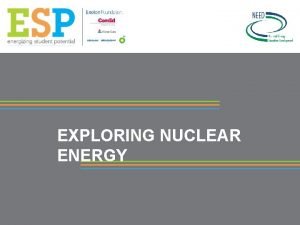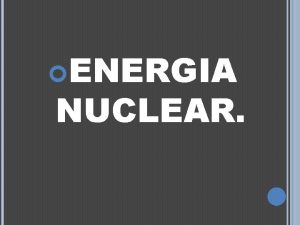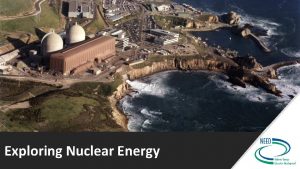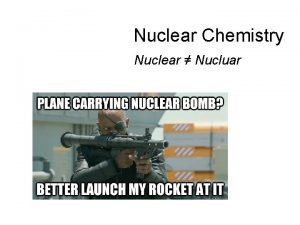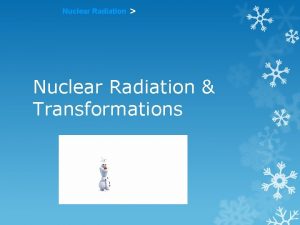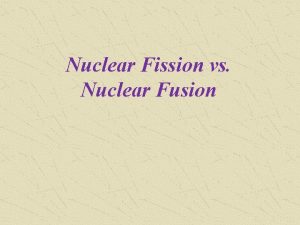NATIONAL COMMISSION FOR NUCLEAR ACTIVITIES CONTROL Monitoring of
























- Slides: 24

NATIONAL COMMISSION FOR NUCLEAR ACTIVITIES CONTROL Monitoring of Radiologically Contaminated Scrap Metal in Romania presented by Alexandru Rodna, Director of Radioprotection and Radioactive Waste Directorate, NATIONAL COMMISSION FOR NUCLEAR ACTIVITIES CONTROL, Romania Slide 1

NATIONAL COMMISSION FOR NUCLEAR ACTIVITIES CONTROL Topics 1. Regulatory Infrastructure 2. Monitoring of the movement of radioactive contaminated scrap metal 3. Removal of detected radioactive materials 4. Contractual provisions governing trade in scrap metal products 5. Reporting 6. National experience gained, conclusions and lessons learned Slide 2

NATIONAL COMMISSION FOR NUCLEAR ACTIVITIES CONTROL 1. Regulatory Infrastructure • In Romania, the national competent authority in the nuclear field, with attributions of regulating, licensing and control, is the National Commission for Nuclear Activities Control (CNCAN) Slide 3

NATIONAL COMMISSION FOR NUCLEAR ACTIVITIES CONTROL 1. Regulatory Infrastructure (continued) • General requirements regarding the safe deployment of nuclear activities in exclusively peaceful purposes are established in Law no. 111/1996, subsequently modified and completed • Requirements regarding the assurance of radiological safety of exposed workers, population and environment are established in Fundamental Norms of Radiological Safety (CNCAN, 2000). Slide 4

NATIONAL COMMISSION FOR NUCLEAR ACTIVITIES CONTROL 1. Regulatory Infrastructure (continued) CNCAN specific norms related to the subject: • Radiological Safety Norms for Operational Protection of Outside Workers, • Radiological Safety Norms – Authorization Procedures, • Fundamental Norms for Safe Transport of Radioactive Materials, • Norms for International Shipments of Radioactive Materials implying Romanian Territory, • Norms for International Shipments of Radioactive Wastes implying Romanian Territory, • Norms for Transport of Radioactive Materials - Authorization Procedures and • Republican Nuclear Safety Norms on the Planning, Preparedness and Intervention in case of Nuclear Accidents and Radiological Emergencies (to be revised this year). Slide 5

NATIONAL COMMISSION FOR NUCLEAR ACTIVITIES CONTROL 1. Regulatory Infrastructure (continued) According to the Romanian Custom Laws (Custom Cod and Custom Regulation) and the specific provision of Law no. 111/1996, the control of radioactive materials imports and exports is the responsibility of National Authority of Customs. Slide 6

NATIONAL COMMISSION FOR NUCLEAR ACTIVITIES CONTROL 2. Monitoring of the movement of radioactive contaminated scrap metal • At the moment, in Romania there isn't a special regulatory requirement related to monitoring imported/exported scrap metals for radioactivity • CNCAN is preparing (to be issued together with the National Authority of Customs), a regulation regarding the radioactivity monitoring of imported and exported shipments. Slide 7

NATIONAL COMMISSION FOR NUCLEAR ACTIVITIES CONTROL 2. Monitoring (continued) • The imported / exported scrap metals are partially monitored for radioactivity, in some road border crossing points with heavy tracks traffic, especially in those situated on the Eastern Romanian Border • Equipment used: – portal gamma monitors – several gamma radiation portable monitors Slide 8

NATIONAL COMMISSION FOR NUCLEAR ACTIVITIES CONTROL 2. Monitoring (continued) • Customs had not implemented yet QA procedures • Customs officers were trained on general knowledge on radiation, practical measuring techniques of the devices and acceptance criteria. • In case of a radiation alarm, the customs officers have to isolate the loading and warn the competent authorities (CNCAN and the General Directorate for Countering Organized Crime and Antidrugs). Slide 9

NATIONAL COMMISSION FOR NUCLEAR ACTIVITIES CONTROL 2. Monitoring (continued) • Some exporters supplement the gamma monitoring performed by notified laboratories with gamma spectrometry – the monitoring laboratories have QA procedures implemented, according to EN-45001 • Some owners of scrap yards, at their initiative, have and use gamma radiation portals and/or portable gamma doseratemeters for monitoring the radioactivity of the scrap metal acquired. Slide 10

NATIONAL COMMISSION FOR NUCLEAR ACTIVITIES CONTROL 2. Monitoring (continued) • Some metal melting facilities monitor output materials, at their own initiative • They have trained personnel in monitoring techniques • There isn't a reporting protocol at all metal processing facilities for detection of radioactive materials and associated action Slide 11

NATIONAL COMMISSION FOR NUCLEAR ACTIVITIES CONTROL 3. Removal of the detected radioactive materials • The removal of the detected radioactive materials is done by the CNCAN or by an authorized organization, at CNCAN request • The legal owner of the source (the former holder) or, if not identified, the owner of the scrap is financial responsible for the disposition of the detected radioactive material • If the owner of the detected radioactive material is not identified, there's a free of charge disposal facility Slide 12

NATIONAL COMMISSION FOR NUCLEAR ACTIVITIES CONTROL 3. Removal of the detected radioactive materials (continued) • There are no protocols for transporting contaminated scrap metal that contain radioactive materials • For transporting detected radioactive materials, both internally and across national borders, in Romania are applied the transport regulations of radioactive material, according to IAEA TS-R-1 Slide 13

NATIONAL COMMISSION FOR NUCLEAR ACTIVITIES CONTROL 4. Contractual provisions governing trade in scrap metal products • The ownership transfers from the seller to the buyer according to the contract, generally at the reception point • When scrap metal is purchased, the contract may state it be radioactive-free • If in a shipment it is found radioactive material after it is unloaded, there is recourse for returning/rejecting the shipment only if the contract specifies so • If cleared scrap metal is sold, the origin of the scrap is clearly stated to the buyer only if it is conditionally cleared • Steel mills and/or smelters are not allowed to melt radiologically contaminated metal Slide 14

NATIONAL COMMISSION FOR NUCLEAR ACTIVITIES CONTROL 5. Reporting • There are no requirements for reporting the alarms at metal processing facilities – the processing facilities shall use authorized organization for performing investigation on found radioactive materials – these facilities are not allowed to accumulate the detected radioactive materials on site • Based on the cooperation between CNCAN and ANV, CNCAN investigates all reports on radiation alarms at border crossing points Slide 15

NATIONAL COMMISSION FOR NUCLEAR ACTIVITIES CONTROL 6. Experience gained • Installations for phosphoric acid production of decommissioned chemical fertilizers plant were measured at the CNCAN initiative and, due to the very high content of Radium deposited inside of some parts of investigated installations, CNCAN interdicted the dismantling and commercialization of such materials. In situ gamma spectrometry at Valea Calugareasca former chemical plant Slide 16

NATIONAL COMMISSION FOR NUCLEAR ACTIVITIES CONTROL 6. Experience gained (continued) • A track, loaded with 20 tones of Aluminum waste, was turned back from the border between Slovenia and Italy; returned in Romania, the track was measured for radioactive materials and it was found an Americium smoke detector. The source was safely removed, transported and delivered as radioactive waste. • At the request of a private scrap yard owner, there were identified Aluminum waste contaminated with Thorium. After the decontamination, the waste was safely removed, transported and delivered as radioactive waste. Slide 17

NATIONAL COMMISSION FOR NUCLEAR ACTIVITIES CONTROL 6. Experience gained (continued) • Dismantling a furnace from a former iron and steel production plant, several Co-60 sources used as radioactive marks of the furnace, were broken and spread with the waste material. The area was decontaminated, the workers were specifically examinees and the owner was punished, according to the national legislation. Gamma doserate measurements at Calan furnace Slide 18

NATIONAL COMMISSION FOR NUCLEAR ACTIVITIES CONTROL 6. Experience gained (continued) • Attempting to entry in Romania, 20 tracks containing TV screens (transit shipment), In situ gamma released un alarm signal of the spectrometry on the portal installed at the border transported TV screen crossing point; the measurements done by the CNCAN investigations team emphasized an enhanced natural radioactive content of the screens transported, situated below the legal contamination level. Gamma portals on the border crossing point Slide 19

NATIONAL COMMISSION FOR NUCLEAR ACTIVITIES CONTROL 6. Experience gained (continued) • Dismantling a cupola for liquid cast iron from a former lathe production plant, 2 Co-60 level gauges were detached and identified by the scrap metal collecting firm. CNCAN investigations team, inspected the radiological situation on site, identifying other 2 Co-60 level gauges attached by another cupola (still in position); no radioactive contamination on site was found, no worker was exposed, the sources was safely removed, transported and delivered as radioactive waste. The Co-60 level gauges attached by the cupola (furnace) still in place Slide 20

NATIONAL COMMISSION FOR NUCLEAR ACTIVITIES CONTROL 7. Conclusions • During the last 5 years, a number of radioactive sources with low activities, used in industry, were discovered in different scrap materials, due to dismantling activities of former plants • With some minor exceptions, the sources were found untouched, no radioactive contamination was emphasized, no exposure of workers and population was detected • In all situation, the radioactive sources were safely removed and delivered as radioactive waste Slide 21

NATIONAL COMMISSION FOR NUCLEAR ACTIVITIES CONTROL 7. Conclusions (continued) • Because of the increasing number of "orphan" low activity sources found in former industrial installations, CNCAN became aware of the necessity of regulating the scrap metal activities • Thus, CNCAN already imposed to the radioactive sources producer, to report the total inventory of produced and distributed sources Slide 22

NATIONAL COMMISSION FOR NUCLEAR ACTIVITIES CONTROL 7. Conclusions (continued) • Also, CNCAN will issue a regulation regarding the monitoring requirements of potentially radioactive contaminated scrap metals, according to the international recommendations • Already, these activities have started, as the Economy and Trade Ministry imposed for the operation of scrap yards, to demonstrate the adequate monitoring capability (recognized by CNCAN) Slide 23

NATIONAL COMMISSION FOR NUCLEAR ACTIVITIES CONTROL 7. Conclusions (continued) • In the same time, there is a need for strengthening the monitoring capability at all border crossing points • CNCAN is preparing a regulation regarding the radiation monitoring requirements in border crossing points • Also, CNCAN intends to issue a protocol with the National Authority of Customs for suitable training of the personnel in monitoring techniques and associated theory notions Slide 24
 Lesson 15 nuclear quest nuclear reactions
Lesson 15 nuclear quest nuclear reactions Fisión nuclear vs fision nuclear
Fisión nuclear vs fision nuclear Defects of existing secondary school curriculum
Defects of existing secondary school curriculum Marie earns an 8 commission for selling appliances
Marie earns an 8 commission for selling appliances Operating activities vs investing activities
Operating activities vs investing activities How do you find these activities
How do you find these activities Support activities and primary activities
Support activities and primary activities Primary and secondary activities
Primary and secondary activities National finance commission
National finance commission The component of agricultural renewal action plan
The component of agricultural renewal action plan Joint commission national patient safety goals 2016
Joint commission national patient safety goals 2016 National finance commission
National finance commission National knowledge commission conclusion
National knowledge commission conclusion Kothari commission aims of education
Kothari commission aims of education Upstream
Upstream National water quality monitoring council
National water quality monitoring council National water quality monitoring council
National water quality monitoring council Nwqmc conference
Nwqmc conference National water quality monitoring conference
National water quality monitoring conference Ganga flood control commission
Ganga flood control commission Fspos
Fspos Typiska drag för en novell
Typiska drag för en novell Nationell inriktning för artificiell intelligens
Nationell inriktning för artificiell intelligens Returpilarna
Returpilarna Varför kallas perioden 1918-1939 för mellankrigstiden?
Varför kallas perioden 1918-1939 för mellankrigstiden?








